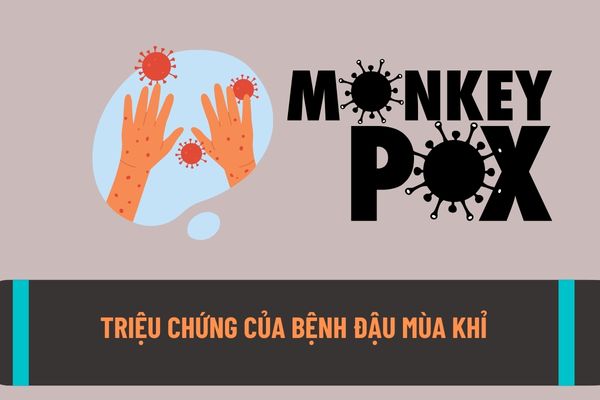What are the symptoms of monkeypox infection? How does monkeypox spread?
Through which routes can monkeypox be transmitted?
According to Section II of the Guidance issued with Decision 2306/QD-BYT of 2022 by the Ministry of Health, the transmission routes of monkeypox are outlined as follows:
- Monkeypox is a smallpox disease caused by a virus (a type of virus transmitted from animals to humans) with symptoms similar to those of historical smallpox. Animal hosts include rodents and non-human primates.
- The monkeypox virus is transmitted from animals to humans through secretions from infected animals, including respiratory droplets or contact with wound secretions.
- Human-to-human transmission of the monkeypox virus occurs during close and prolonged contact with an infected person. Transmission routes include respiratory droplets during face-to-face contact or direct contact with skin lesions of the infected person and contaminated objects.
- Transmission can also occur from a contaminated environment to humans, such as through clothing, bed linens with contaminated skin particles. Washing, handling of fabric items, or other fabric-disturbing activities can release these skin particles into the air.
- Transmission can occur by inhaling contaminated skin particles in the air or when particles come into contact with sensitive areas such as broken skin or mucous membranes on the body.
- Mother-to-fetus transmission can occur through the placenta.
- In the 2022 outbreak, many cases occurred due to transmission during sexual or intimate contacts, possibly due to direct contact with monkeypox lesions or direct contact with respiratory secretions of an infected person. Many current monkeypox cases are among men who have sex with men and bisexual individuals.
- Infection of monkeypox within healthcare facilities has been documented worldwide.
Monkeypox can be transmitted from animals to humans, from humans to humans, through sexual transmission, and from mother to fetus, among other routes.

What are the symptoms of monkeypox infection? Through which routes can monkeypox be transmitted?
What symptoms will appear when infected with monkeypox?
Based on Subsection 3, Section I of the Guidance issued with Decision 2306/QD-BYT of 2022 by the Ministry of Health, the symptoms of monkeypox are outlined as follows:
- Incubation period: from 6 to 13 days (ranging from 5 days to 21 days). The infected person shows no symptoms and is not capable of spreading the infection.
- Prodromal stage: from 1 to 5 days, with primary symptoms being fever and generalized peripheral lymphadenopathy. Accompanying symptoms may include headaches, fatigue, chills, sore throat, and muscle pain. The virus can be transmitted to others from this stage.
- Eruptive stage: characterized by the appearance of rashes, typically occurring 1 to 3 days after fever onset, with the following characteristics:
+ Location: Rashes tend to be centrifugal, found mostly on the face, palms, and soles. Rashes may also appear in the mouth, eyes, and genitalia.
+ Rash progression: Sequential evolution of rashes from macules (flat lesions) - papules (slightly raised hard lesions) - vesicles (fluid-filled lesions) - pustules (yellow fluid-filled lesions) - dry scabs - peeling and can leave scars.
+ Lesion size: Average from 0.5 cm to 1 cm.
+ The number of skin lesions on one person can range from a few spots to densely distributed. In severe cases, lesions may merge into large patches of skin damage.
- Recovery stage: Monkeypox symptoms can last from 2 to 4 weeks before resolving on their own. The patient recovers from clinical symptoms, but skin scars may affect aesthetics, and there is no risk of transmitting the infection to others.
- Diagnostic test for monkeypox: Molecular biological test (PCR or equivalent) with oropharyngeal fluid specimens (prodromal stage) and vesicular fluid specimens (eruptive stage) for suspected cases to determine the cause as per the Ministry of Health's regulations.
According to the above guidance, an individual infected with monkeypox will go through 4 stages: incubation; prodromal; eruptive; and recovery. In each stage, specific symptoms will manifest as guided.
Does monkeypox lead to mortality?
Based on Subsection 4, Section I of the Guidance issued with Decision 2306/QD-BYT of 2022 by the Ministry of Health, the complications of monkeypox infection are discussed as follows:
- Common complications of monkeypox include sepsis (which can be life-threatening), encephalitis, bronchopneumonia, corneal infection, and loss of vision. Severe skin wounds can lead to large areas of skin peeling off.
- The fatality rate for monkeypox ranges from 3%-6% of infected individuals, with a higher mortality rate in children infected with monkeypox.
Individuals infected with monkeypox may encounter complications such as sepsis, encephalitis, bronchitis, loss of vision, among others.
The fatality rate for monkeypox infection is approximately 3% to 6%. Children infected with monkeypox will have a higher mortality rate.
LawNet
